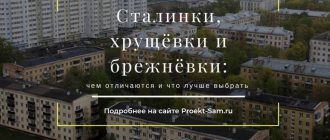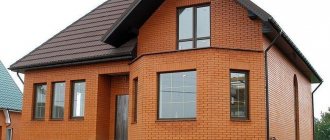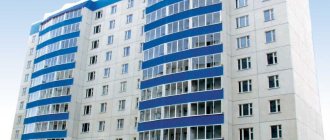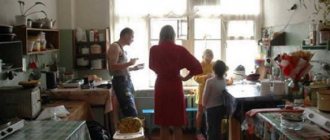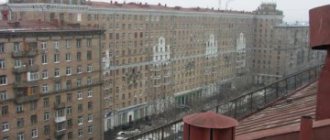Life time
There are two types of Khrushchev buildings - panel and brick. Panel houses were mainly erected as temporary structures and had a service life of 25 years. However, many of them still stand to this day, since the service life of these houses is constantly being increased.
Brick structures are stronger and more reliable; according to design data, such a house can last at least 50 years. At the same time, many Khrushchev buildings made of brick had their service life extended to 150 years. Therefore, in small towns across the country, such houses will remain standing for decades to come; there is no plan to demolish these structures.
Service life of buildings according to SNIP
The table shows the approximate service life of various buildings.
How to avoid paying for major repairs, read the link.
| Buildings and structures erected for temporary residence (kiosks, pavilions, cabins for builders and workers, market structures) | 10 years |
| Buildings and structures operated under aggressive environmental influences (pipelines, chemical industry tanks, storage facilities, etc.) | 25 years |
| Industrial, residential and commercial buildings of mass construction (residential buildings, industrial buildings, shops, public service buildings, etc.) | From 50 years old |
| Unique buildings, buildings of cultural value (stadiums, theaters, museums, repositories of national treasures) | From 100 years and above |
Examination of the condition of a residential building
The assessment of a residential building is carried out by expert groups, both state and independent. It can be carried out either planned or based on statements from residents who believe that their house does not meet the necessary standards.
Reasons for examination:
- Excessive wear and tear on a residential building;
- Non-compliance with required standards;
- Trial.
Find out how to determine which area is adjacent to your home by following the link.
The procedure for inspecting a building by experts looks like this:
- Visual assessment of all systems of a residential building (foundation, supporting structures, sanitary systems);
- Instrumental assessment of all systems of a residential building;
- Inspection of living conditions (quality of drinking water, sewerage, air and soil pollution).
What ODN is and how you can calculate it yourself is described in this article.
Based on the examination, a conclusion is made about the suitability of the house. If the wear is more than 70%, it will be considered emergency. A slightly lower degree of wear and tear is also a reason for either demolition of the building or major repairs.
How much do houses cost?
If the house is not recognized as unsafe, but certain aspects in the conclusion are considered to be non-compliant with the standards, the question of reconstruction and finishing of the building will be raised.
How you can manage an apartment building, read more here.
When the house reaches its last days
A decision on the unsuitability of a residential building is made by a judicial commission based on the conclusion of an expert group.
What work must be included in the landscaping of the territory, read the link.
If a decision is made, the building has two options:
- Major renovation. For it, two conditions must be met: the technical feasibility of the repair and its feasibility. Repairs can be carried out if the building has a safety margin and there are no serious risks for its occupants.
- Demolition.
A building recognized as unsafe and potentially dangerous is subject to demolition. Residents are resettled in new apartments, which should be similar in size to those in which they lived. As a rule, a new building is built on the site of a demolished building; in some cases, former residents of an old building can get an apartment in this new building.
Which house is better, watch in this video:
Our country's housing stock is gradually deteriorating. The country inherited a huge number of residential buildings from the Soviet Union, and many of them could very soon become unsafe. Resolving issues regarding the construction of new houses is one of the most important tasks facing the state.
Short story
It is worth noting that such houses began to be built under Stalin, but in much smaller numbers. The massive construction of these structures began with Nikita Sergeevich coming to power, and it is in his honor that these houses are called Khrushchevka.
The author of such inexpensive and small-sized houses was not the Chief Secretary of the Party or people close to him. The USSR government borrowed the idea of inexpensive houses from the Frenchman Le Corbusier, it was this man who proposed starting the construction of such small houses in France. After all, this country was almost completely destroyed after the Second World War, and there was no money to build quality houses.
This idea of the French architect was made even more rational in the USSR, so the construction of Khrushchev-era buildings began throughout the country. Moreover, sometimes not only entire districts, but also entire cities were built with such houses.
New in blogs
The authorities promise that by 2015 there will be no more old Khrushchev buildings left in Moscow.
The Moscow authorities have resumed the demolition of dilapidated five-story buildings - the oldest "Khrushchev" buildings, of which there are more than 300 in the city. It is planned to say goodbye to them completely by 2015. But for the rest of Russia, such “Khrushchev” will remain a reality for a long time.
Today, according to rough estimates, 8.6 million Russians live in Soviet five-story buildings.
There is no exact data on their deterioration, but it is known that even in Moscow there are still many five-story buildings built in the late 1950s and designed to last 25 years.
The grandson of the creator of the first “Khrushchev” projects, Vitaly Lagutenko, rock musician Ilya Lagutenko, believes that they are in no way inferior to municipal free housing in London.
The Russian authorities are optimistic about the problem of five-story buildings: thanks to modern renovation technologies, the life cycle of these houses, officials say, can be increased to 150 years.
Experts counter that, firstly, modern technologies are not available everywhere, and even if they are available, they are not followed everywhere. Secondly, one and a half centuries is the most optimistic forecast, assuming ideal operating conditions.
Thirdly, in addition to the houses themselves, communications (electrical wiring, heating, water supply) are becoming outdated, and this is also a source of constant threat.
However, given the underfunded housing sector, there is no quick and easy solution to this problem. After all, even in Moscow, the program for the demolition and resettlement of dilapidated housing is constantly stalled.
Cost of destruction
By the beginning of this fall, there were 317 five-story buildings in the Russian capital, dating back to the “first period of industrial housing construction” (built before the end of the 1960s).
"Khrushchev"
- “Khrushchevka” refers to houses built in the Soviet Union over almost 30 years: from the late 1950s to 1985. They are panel or brick, have three to five floors - as a rule, with poor sound insulation.
- The first experimental “Khrushchev” buildings were designed under Joseph Stalin. The author of the project is considered to be the head of the first Mosproekt workshop, Vitaly Lagutenko (grandfather of Ilya Lagutenko from Mumiy Troll).
- The four-entrance, five-story house of the K-7 series was installed in a record 12 days, thanks to the round-the-clock work of builders in three shifts.
- It is believed that the first “Khrushchev” in Moscow was built on Grimau Street (house 16). The building is still preserved, as are almost 200 more houses of the K-7 series.
- The construction of “Khrushchev” buildings allowed millions of Soviet families to move from barracks and communal apartments to individual apartments.
- As of August 2013, the average cost of a Khrushchev house in Moscow was 6.9 million rubles in a panel house and 7.7 million rubles. in brick (averaged data for 1-3-room apartments).
One five-story building has an average of 60 apartments, in which a maximum of 200 people can live. That is, we are talking about the resettlement of 63.4 thousand people.
It was planned to demolish these houses three years ago, but the economic crisis and a change in city leadership prevented it. Now local authorities are calling another date - 2015.
But this may also be in question, because dismantling a five-story building is neither easy nor cheap - even in Moscow, where undeveloped square meters are worth their weight in gold.
“After 60 years, due to the expansion of the cities themselves, Khrushchev buildings began to be located either very close to the central part, or close to the middle part of the cities, where there was a significant density of development and laying of utilities,” says a member of the board of the Gosstroy of Russia, vice-president of the Russian Union of Engineers Ivan Andrievsky.
Therefore, the cost of demolishing the building has increased significantly, he says. In addition, the residents of these houses are in no hurry to leave them.
“Many of them are already elderly, and it’s hard for them to survive. In addition, if previously residents of demolished five-story buildings were offered housing in the same area and with a larger square footage, now they will offer you an apartment outside the Moscow Ring Road, and the square footage will be the same,” the expert notes.
Invincible
However, there is no need to worry too much about the future of five-story buildings, continues Ivan Andrievsky.
“Surprisingly, the service life of the Khrushchev buildings - not calculated, but actual - reaches 150 years. To date, about 65 years have passed since the construction of the first “Khrushchev” buildings in 1948. On average across the country, such houses are 60 years old and younger,” he calculates.
This means that they will be able to stand for about 90 more years.
In addition, engineers, according to him, have developed a new method for reconstructing Khrushchev buildings: the houses are strengthened with columns, sound and heat insulation is enhanced, the number of floors is increased, and by combining apartments, the living space is increased.
True, this method is still under discussion - in particular, in the relevant State Duma committee on construction.
At home we're tired of enduring
How many square meters are there in Russia?
- The total housing stock in Russia is 3.3 billion square meters. meters. Of these, 200 million sq. meters (6.06%) are Khrushchev buildings.
- Dilapidated and emergency housing, that is, with deterioration above 70%, amounts to 100 million square meters. meters. Moreover, this figure does not include data on “Khrushchev” buildings - they are difficult to find in the public domain.
- Over the last 10 years of the USSR's existence, Russia's housing stock has grown by 50%. During 2005-2011, the housing stock grew by 11.25%.
- The housing supply level in Russia is 23 square meters. meters of housing per person. In developed countries this figure is two to three times higher: in the USA – 75 square meters. meters per person, in the UK – 62 sq. meters.
- The level of construction activity in Russia over the past 10 years has fluctuated in the range of 0.22-0.45 square meters. meters per person per year. According to experts, for fundamental changes for the better, this figure should reach 1 square. meters per person per year.
- But even then, Russia will be able to reach the level of housing provision of the European Union countries only in 16 years.
However, many are sounding the alarm: the deterioration of the communal infrastructure in the country reaches 60%, and dilapidated five-story buildings are not far behind the infrastructure in terms of deterioration.
“Our pipes started bursting earlier, and utility accidents also happened, but at home we suffered for quite a long time. But for two years now we have been periodically hearing about the collapse of ceilings, or about a collapsed wall of a house,” worries Galina Khovanskaya, who heads the State Duma Committee on Housing Policy and Housing and Communal Services.
While in Moscow the program for the renovation of neighborhoods built up with Khrushchev buildings is being implemented, in the regions it has not even begun, the deputy says.
An example in the matter of renovating dilapidated housing stock, according to her, should be taken from some European countries: “In Germany, for example, the residents of the house went to visit relatives for two days, arrived - all things were safe, nothing was missing or damaged, and repairs completed."
The Russian state, of course, allocates money for the resettlement of dilapidated and dilapidated housing. A significant part of this money (more than 250 billion rubles, according to Khovanskaya) passes through the Housing and Communal Sector Reform Assistance Fund, launched in 2005.
Now, however, most of these funds are not used for reconstruction or repairs, but for the resettlement of residents of dilapidated houses, the number of which is growing exponentially throughout the country, Khovanskaya complains.
House series 1-511
Today, Khrushchev buildings can be seen quite often in Moscow; this series is the most common in the capital, so it is advisable to talk about it.
These five-story buildings are present in almost every district of Moscow; they have been built over the course of 10 years. There are two modification options: early and late, but they differ only in minor differences in ceiling height and brick quality.
It is worth noting that, if we compare other brick Khrushchev buildings with 1-511, then in this series higher quality brick was used. After all, the houses were erected in the capital of a great state. As for the layout, everything here is the same as in other houses: walk-through rooms, a small kitchen and a bathroom.
Khrushchev: 5 undeniable advantages
Yes, their mass construction began in the late 50s of the last century. And the main goal of such a large-scale development was not the creation of ultra-comfortable personal space, but the basic satisfaction of citizens’ needs for separate housing. But it was precisely these two factors together that provided the gray “Khrushchevs” with their first advantage. Due to the fact that moving from barracks and communal apartments to a separate apartment was considered a manifestation of the highest happiness in life ( as, indeed, now - author.
), in many families the cult of caring for the home has been preserved.
Will Khrushchev buildings be demolished in Moscow?
Almost all Khrushchev buildings in the capital are of the 1-511 series and will not be demolished, since they are still in fairly good condition and can last for decades. There are only a few buildings of this model that are subject to demolition, but they are already in an emergency situation.
Regarding the question of whether the brick Khrushchev buildings will be demolished or not, it is quite difficult to answer unequivocally. In April 2021, the mayor of the Russian capital announced that strong houses would not be demolished. Only those five-story buildings that are in unsatisfactory condition are subject to demolition.
Some buildings will remain as they are at the moment, and local authorities plan to reconstruct some of the houses and add more floors. The strongest structures will become taller, and it is planned to build elevator units in them. Therefore, some of the brick buildings will become modern houses, with new and better apartments. Residents of the lower floors will be able to redevelop brick Khrushchev buildings.
Redevelopment of a two-room apartment
Almost all brick Khrushchev buildings have adjacent rooms. One room is still not bad, but the second is very narrow, where a large bed does not always fit. In the vast majority of cases, such houses are suitable for redevelopment, since the apartment has practically no load-bearing walls. However, before this procedure, it is imperative to consult which walls can be destroyed and which cannot. Otherwise, there may be very big problems with the structure.
Usually in Khrushchev-era apartments there is a sit-down bathtub, since an ordinary one simply does not fit. Therefore, the owner of such an apartment is faced with the task of increasing the space so that it is comfortable to live here. The following photo shows a standard redevelopment of a brick Khrushchev building.
As you can see, the wall between the kitchen and living room was knocked down, creating extra space for the kitchen area, while also making the living room feel larger and more modern. The living room was separated using sliding doors, creating a small work area. You can put a corner bath in the bathroom, which will take up a little less space, but at the same time it will be full-fledged, and not sit-down. As for the washing machine, it is often placed under the washbasin in brick Khrushchev-era buildings. Or you can purchase a built-in model and install it in the kitchen.
In the room where the bedroom is located there is a small storage room. After the redevelopment, this space was enlarged to create a dressing room. The bedroom itself has lost some area, but now there is no need to place a closet, and the room has become more square, rather than long and narrow.
